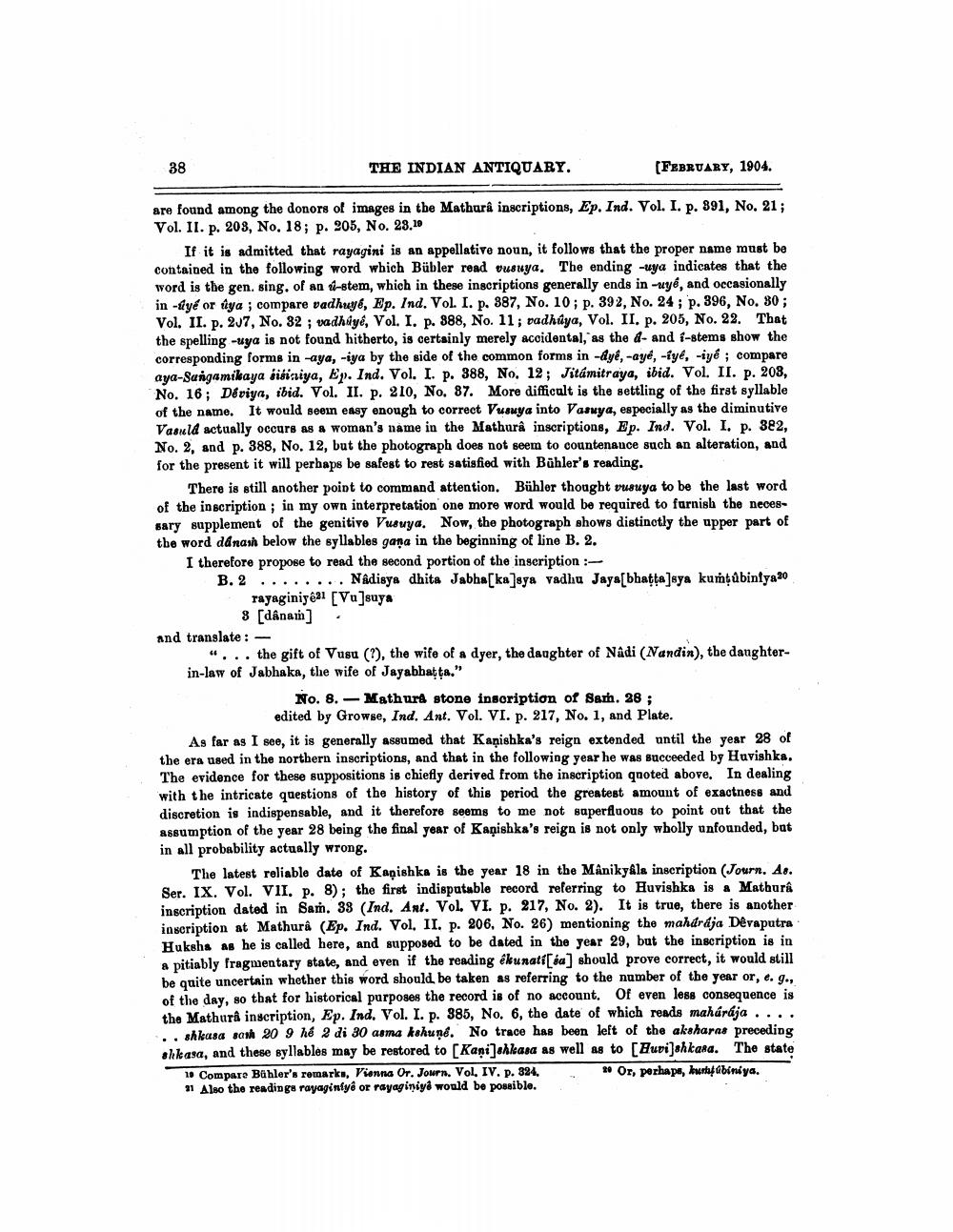________________
38
THE INDIAN ANTIQUARY.
(FEBRUARY, 1904.
are found among the donors of images in the Mathurâ inscriptions, Ep. Ind. Vol. I. p. 891, No. 21; Vol. II. p. 203, No. 18; p. 205, No. 23.10
If it is admitted that rayagini is an appellative noun, it follows that the proper name must be contained in the following word which Bübler read uusuya. The ending -uya indicates that the word is the gen. sing. of an 1-stem, which in these inscriptions generally ends in -uyê, and occasionally in-syé or úya ; compare vadhuyé, Ep. Ind. VOL. I. p. 387, No. 10; p. 392, No. 24 ; p. 396, No. 80; Vol. II. p. 237, No. 32 ; vadhiye, Vol. I. p. 388, No. 11; vadhúya, Vol. II. p. 205, No. 22. That the spelling -uya is not found hitherto, is certainly merely accidental, as the d- and f-stems show the corresponding forms in -aya, -iya by the side of the common forms in -dye, -ayé, -iye, -iye ; compare aya-Sangamikaya biniya, Ep. Ind. Vol. I. p. 388, No. 12; Jitámitraya, ibid. Vol. II. p. 208, No. 16; Deviya, ibid. Vol. II. p. 210, No. 87. More difficult is the settling of the first syllable of the name. It would seein easy enough to correct Vusuya into Vasuya, especially as the diminutive Vasuld actually occurs as a woman's name in the Mathura inscriptions, Ep. Ind. Vol. I, p. 382, No. 2, and p. 388, No. 12, but the photograph does not seem to countenance such an alteration, and for the present it will perhaps be safest to rest satisfied with Bühler's reading.
There is still another point to command attention. Bühler thought vusuya to be the last word of the inscription; in my own interpretation one more word would be required to furnish the necessary supplement of the genitive Vusuya. Now, the photograph shows distinctly the upper part of the word danash below the syllables gana in the beginning of line B. 2. I therefore propose to read the second portion of the inscription : B. 2 ........ Nadisya dhita Jabha[ka]sya vadhu Jaya(bhatta]sya kumsubintya80
rayaginiyê21 [Vu]suya
8 [dâna] and translate : -
“... the gift of Vusu (?), the wife of a dyer, the daughter of Nadi (Nandin), the danghterin-law of Jabhaka, the wife of Jayabbatta."
No. 8.- Mathurd stone inscription of Sam. 28;
edited by Growse, Ind. Ant. Vol. VI. p. 217, No. 1, and Plate. As far as I see, it is generally assumed that Kaņishka's reign extended until the year 28 of the era used in the northern inscriptions, and that in the following year he was succeeded by Huvishka. The evidence for these suppositions is chiefly derived from the inscription qnoted above. In dealing with the intricate questions of the history of this period the greatest amount of exactness and discretion is indispensable, and it therefore seems to me not superfluous to point out that the assumption of the year 28 being the final year of Kanishka's reiga is not only wholly unfounded, but in all probability actually wrong.
The latest reliable date of Kapishka is the year 18 in the Manikyals inscription (Journ. As. Ser. IX. Vol. VII. p. 8); the first indisputable record referring to Huvishka is a Mathurâ inscription dated in Sam. 33 (Ind. Ant. Vol. VI. p. 217, No. 2). It is true, there is another inscription at Mathurâ (Ep. Ind. Vol. II. p. 206, No. 26) mentioning the mahdrája Dêvaputra Hukshs as he is called here, and supposed to be dated in the year 29, but the inscription is in a pitiably fragmentary state, and even if the reading ékunati[ba] should prove correct, it would still be quite uncertain whether this word should be taken as referring to the number of the year or, e. g., of the day, so that for historical purposes the record is of no account. Of even less consequence is the Mathura inscription, Ep. Ind. Vol. I. p. 385, No. 6, the date of which reads mahárája .... .. shkasa sanh 20 9 hé 2 di 30 asma kshund. No trace has been left of the akaharas preceding shkasa, and these syllables may be restored to [Kani]ahkasa as well as to [Huvi]shkasa. The state
10 Compare Bühler's remarks, Vienna Or. Journ. Vol. IV. p. 324. . ? Or, porhaps, burkafübiniya. 1 Also the readings rayaginiyê or rayaginiyê would be possible.




